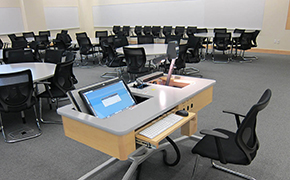Instructor Insights pages are part of the OCW Educator initiative, which seeks to enhance the value of OCW for educators.
Course Overview
This page focuses on the course 15.031J Energy Decisions, Markets, and Policies as it was taught by Professor Richard Schmalensee in Spring 2012.
This course examined the choices and constraints regarding sources and uses of energy by households, firms, and governments through a number of frameworks to describe and explain behavior at various levels of aggregation. Examples included a wide range of countries, scopes, settings, and analytical approaches.
Course Outcomes
Course Goals for Students
Our main goals were to show students first that energy-related problems are not just technical/engineering problems; they generally have important economic, political, and social dimensions and, second, that the tools of social science can help one understand and take action on those dimensions. The course was intended to provide education, not training; we hoped that students in later life would know enough to seek out and learn specific tools as needed.
Possibilities for Further Study/Careers
This course was required for undergraduate Energy Studies minors, but drew many students from beyond that minor.
We […] emphasized class discussion and interaction.
—Richard Schmalensee
Below, Professor Richard Schmalensee describes various aspects of how he taught 15.031J Energy Decisions, Markets, and Policies.
15.031J Energy Decisions, Markets, and Policies was normally taught by a team of instructors (the single-instructor format that was recorded for publication on OCW was atypical). Our team worked together on all aspects of designing the course—from curating the reading list to developing the details of the assignments. With the exception of the Spring 2012 offering of the course, we were all in the classroom during each class session. This led to engaging discussions between instructors and interjections that allowed students to see different ways of approaching the issues at the center of our curriculum. Students valued this opportunity.
As a team, we also emphasized class discussion and interaction to a greater degree than most undergraduate courses because we were accustomed to teaching MIT Sloan MBA students. In fact, two of our pedagogical decisions were specifically designed to engage students in learning from each other. For example, we created the team paper assignment to give students an opportunity to work collaboratively while delving more deeply into a topic of interest. We also included oral presentations of the final team papers to create opportunities for students to learn from (and to be critical of) the work of their colleagues.
Curriculum Information
Prerequisites
14.01 Principles of Microeconomics is a prerequisite for taking this course.
Requirements Satisfied
HASS-S ![]()
Offered
This course is occasionally offered during the fall semester.
Assessment
The students' grades were based on the following activities:
 10% Individual paper
10% Individual paper 40% Quizzes
40% Quizzes 40% Team project
40% Team project 10% Class participation
10% Class participationStudent Information

Breakdown by Year
Almost all juniors or seniors, with more juniors than seniors. Typically, one or two graduate students particpated as listeners.
Breakdown by Major
The majority of students were from the School of Engineering, mainly chemical and mechanical majors. There were also a few economics and management majors. Very few students were from the Schools of Science or Architecture & Planning.
Typical Student Background
Students’ backgrounds varied a lot. We required only basic microeconomics, but some were economics majors, and others had forgotten much of the economics they had learned. Some had held summer jobs in the energy industry or in environmental organizations concerned with energy-related issues; others knew nothing at all about energy production or use.
Ideal Class Size
The class size should small enough to permit discussion – perhaps around 50 or 60 students maximum.
During an average week, students were expected to spend 12 hours on the course, roughly divided as follows:
Lectures
- Met 2 times per week for 90 minutes per session; 24 sessions total; mandatory attendance.
- Class sessions varied. Some were lectures; others were mainly discussions of cases. We devoted two sessions to a climate change negotiation game.
- We used a climate change negotiation game both to emphasize important aspects of the climate change policy problem and to break the ice by encouraging students to interact with each other and by interacting with them very informally.
Recitation
- 1 time per week for 90 minutes per session.
- Recitation sessions often covered specific topics or tools not covered in the lectures.
Out of Class
- TAs held regular office hours that the students utilized, but few sought out professors outside class.
- Students completed required readings and assignments.
Semester Breakdown
| WEEK | M | T | W | Th | F |
|---|---|---|---|---|---|
| 1 |  |  |  |  |  |
| 2 |  |  |  |  |  |
| 3 |  |  |  |  |  |
| 4 |  |  |  |  |  |
| 5 |  |  |  |  |  |
| 6 |  |  |  |  |  |
| 7 |  |  |  |  |  |
| 8 |  |  |  |  |  |
| 9 |  |  |  |  |  |
| 10 |  |  |  |  |  |
| 11 |  |  |  |  |  |
| 12 |  |  |  |  |  |
| 13 |  |  |  |  |  |
| 14 |  |  |  |  |  |
| 15 |  |  |  |  |  |
| 16 |  |  |  |  |  |
 No classes throughout MIT
No classes throughout MIT Lecture session
Lecture session Student Presentations
Student Presentations Quiz
Quiz No class session scheduled
No class session scheduled Recitation session
Recitation session Assignment due date
Assignment due date

 Room 1 of 2
Room 1 of 2 
